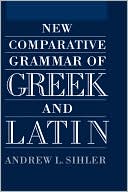

 |

|

The average rating for New Comparative Grammar of Greek and Latin based on 2 reviews is 4.5 stars.
Review # 1 was written on 2010-01-22 00:00:00 Kevin Chaloupka Kevin ChaloupkaAndrew Sihler's New Comparative Grammar of Greek and Latin was initially envisioned as a simple update of C.D. Buck's classic comparative grammar of Greek and Latin, with just some updates to take into account such things as laryngeal theory. However, Sihler's undertaking, which was begun in 1986, came to produce a fascinating book that brings evidence in from all the Indo-European languages and serves as a key text for anyone entering the field of Indo-European linguistics. Sihler's work was published in 1995, and while some progress has occured in the field since, the vast majority of his book is still state-of-the-art. Sihler's book assumes some knowledge of the fundamentals of historical linguistics. While Sihler's revision here cut out Buck's original presentation of these basics, Sihler did write a new introduction that was published by John Benjamins as a separate book (ISBN 1556199694). Except for that, Sihler does try to start from the very beginning here: we find a presentation of all the branches of Indo-European and the ancient languages that are so vital to reconstruction. Now, I don't think that Sihler's work would serve a *total* beginner in Indo-European linguistics well -- try, say, Clackson's textbook (ISBN 0521653673) or Lehmann's Theoretical Bases of Indo-European Linguistics. However, it will still appeal to relative newcomers to the field. The meat of the book is the comparison of how the grammar of the reconstructed Proto-Indo-European was transformed into Greek and Latin. This is divided into the parts Phonology, Declension, Pronouns, Numerals and finally Conjugation. Now, looking at just some of the sample pages online will give a better idea of the book's contents than I can. Nonetheless, I'll offer some comments. The Phonology part is straightforward: for each of the reconstructed PIE phonemes, Sihler shows their different reflexes in G and L. The Declension part is nice for understanding the Latin fourth and fifth declensions, which are of mysterious origin. For the reconstructed PIE verb conjugatins, Sihler goes with the view that it was based on an stative-eventive distinction, though he does mention that the Hittite evident suggests that this system arose from an earlier, different one. There is an index of all Latin and Greek words cited in the text, as well as the vocabulary items brought in from other IE languages. The great downside of Sihler's work is its lack of references. You'll find no citations to any literature to back up Sihler's reconstructions, and there's not even a list of further reading. It can be frustrating to see various assertions made without getting any idea of Sihler's sources. This stops it from being a truly great work. Still, I've gained enormous profit from Sihler's book and it does have "practical" application. In my undergraduate studies in Classics, internalizing the changes that produced Greek and Latin from PIE helped me in reading passages where I didn't know a Greek word but could guess it from the Latin or vice versa. Similarly, knowing the history of the conjugation made it much easier to deal with the erratic principle parts of Greek verbs. |
Review # 2 was written on 2020-02-28 00:00:00 GARY BRAMMER GARY BRAMMERThis one is a lot of fun. Sihler revisits Carl "Darling" Buck's 1933 original, retaining passages where warranted and updating where needed, to trace the development of both Latin (and, to a lesser extent, the other Italic languages) and Greek from Proto-Indo-European in excruciating phonological and morphological detail, drawing comparisons not just to each other but to a formidable number of other IE languages'just the ones with their own indexes number eighteen (or more, since closely related languages are combined in a few cases'though in fairness, the Albanian index consists of two data). Along the way he provides a shockingly good introduction to PIE itself, though as concepts are introduced when they make sense in the context of the book rather than in a way that makes the most sense in their own right, a modest former exposure will be helpful. The result is a truly incredible piece of work well worth the time of any classicist, linguist, or collector of etymology, both to read cover to cover and to keep as a reference work. A solid prior understanding of both languages isn't optional, but it's worth learning Greek just for this book. |
CAN'T FIND WHAT YOU'RE LOOKING FOR? CLICK HERE!!!